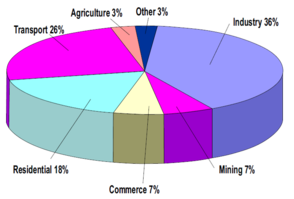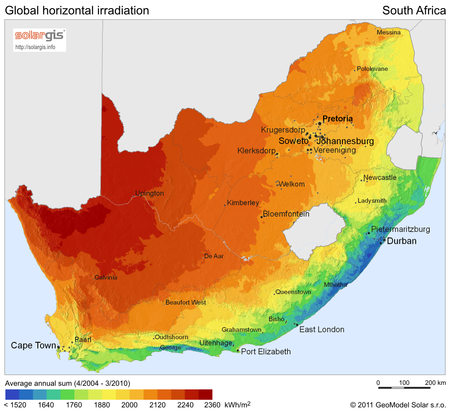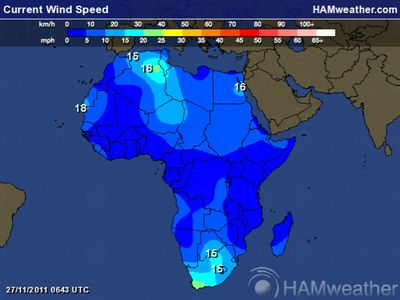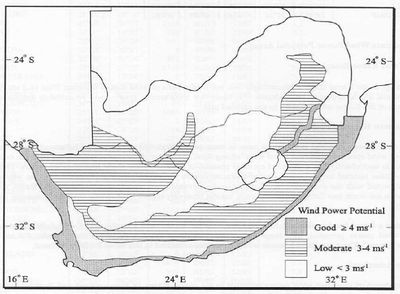Knowledge fuels change
For over a decade, Energypedia has shared free, reliable energy expertise with the world.
We’re now facing a serious funding gap.
Help keep this platform alive — your donation, big or small, truly matters!
Thank you for your support
South Africa Energy Situation
| South Africa | |||
|---|---|---|---|
| Capital | Pretoria | ||
| Official Languages(s) |
11 Official languages with Zulu being the most spoken language | ||
| Government | Democratic Republic | ||
| President | Jacob Zuma[1] | ||
| 'Total Area '( km²) | 1211037[2] | ||
| Population | 52981991[3] | ||
| Rural Population | (year) | ||
| GDP (Nominal) | US $ 471178 Billion (2011)[4] | ||
| GDP Per Capita | US $ (year) | ||
| Currency | Rand | ||
| Time Zone | UTC/GMT +2 hours | ||
| Electricity Generation | TWh/year (year) | ||
| Access to Electricity | 75 % | ||
| Wind energy (installed capacity) | MW (year) | ||
| Solar Energy (installed capacity) | MW (year) | ||
Overview
- Coal supplies 65.7% of the primary energy*
- Followed by crude oil with 21.6%
- Renewable and wastes with 7.6 %
- Gas with 2.8%
- Nuclear 0.4%
- Hydro 0.1%[5]

Economy General
- 1 Euro ~ 11 south African Rand (ZAR).
- GDP ~ 3080 Billion ZAR ~ 280 Billion Euro.
- Exports amounted to 24% of GDP in 2010.
- Large and active stock exchange that ranks 17th in the world.[6]
- Active member of BRICS
- BRICS is an international political organisation of leading emerging economies with a developing middle income status and it comprises of Brazil, Russia, India, China and South Africa.
Hydropower
Till date hydropower contributes only 0.1% of the South African Energy supply.[7]
The Baseline Study on Hydropower in South Africa, an assessment conducted by the DME in 2002, indicated that specific areas in the country show significant potential for the development of all categories of hydropower in the short and medium term.
The Eastern Cape and KwaZulu-Natal are endowed with the best potential for the development of small, i.e. less than 10MW hydropower plants. The advantages and attractiveness of these plants are that they can either be standalone or in a hybrid combination with other renewable energy sources. Advantage can be derived from the association with other uses of water (water supply, irrigation, flood control, etc.), which are critical to the future economic and socio-economic development of South Africa.
The Southern African Power Pool (SAPP) allows the free trading of electricity between Southern African Development Community (SADC) member countries, providing South Africa with access to the vast hydropower potential in the countries to the north, notably the significant potential in the Congo River (Inga Falls).[8]
Solar Energy
Most areas in South Africa average more than 2 500 hours of sunshine per year, and average solar-radiation levels range between 4.5 and 6.5kWh/m2 in one day.
The southern African region, and in fact the whole of Africa, has sunshine all year round. The annual 24-hour global solar radiation average is about 220 W/m2 for South Africa, compared with about 150 W/m2 for parts of the USA, and about 100 W/m2 for Europe and the United Kingdom. This makes South Africa's local resource one of the highest in the world. [9]The South-west region has the most potential for solar in South Africa as can be seen from the above graph.
Market Entry Barrier
There are no particular barriers for entering the market but following Steps need to be followed for setting up a Solar Power Plant/Project:
- Application-Department of Energy(DOE) invite Potential developers to submit their application/ proposals
- Allotment -DOE with then assign a particular developer for the project after considering thier prices, proposals etc. It is a confidential process within DOE.
- PPA-The successful bidders / developer then signs Power Purchase agreement (PPA) with Eskom(South africa biggest utility).
- Land Acquisition
- EPC- The sucessful bidder/project owner/ developer then hire an Engineering, Procurement and Constrcution (EPC) company for sucessful implementation of the project.
- Commissioning- EPC handover the project to the owner after commisoning of the project and connecting it to the Grid .
Biomass
South Africa has tremendous biofuel potential when considering the capacity to grow total plant biomass (all lignocellulosic plant biomass. According to conservative estimates, South Africa produces about 18 million tonnes of agricultural and forestry residues every year. The South African biofuels target for 2008‐2013, according to Industrial Biofuels Strategy (2007), has been fixed at 2% penetration level in the national liquid fuel supply, which corresponds to 400 million litres per annum. When considering the use of 50‐70% of this plant biomass with second generation biochemical and thermochemical technologies, South Africa has the potential to substitute the bulk of its current liquid fossil fuel usage (currently 21.2 BL/annum) with renewable biofuels. However, the only real activity has been US$437 million investment by the South Africa’s Industrial Development Corporation (IDC) and Energy Development Corporation (EDC) in two biofuels projects that will collectively produce 190 million litres of bioethanol from sugarcane and sugarbeet.[10]
Biogas
Wind Energy
South Africa has an excellent wind resource which is dispersed geographically.
Cost of wind power already competitive with New coal and shall reach grid parity by 2016/2017[11]
Current estimates of South Africa's potential wind capacity varies greatly, from 3 GW to 70 GW.
There is political support for renewable energy in the country; the South African government has set a target of 10,000 GWh of renewable energy by 2013, produced mainly by biomass, wind, solar and small scale hydro.
However the targets set for wind energy are small. In the short term, the renewable energy plan only includes 500 MW of wind power until 2013, of which 400 MW would be commissioned from independent power producers.
Geothermal Energy
There is, currently, no large-scale geothermal production in South Africa, since coal is abundant and relatively cheap, supplying the largest part of the country’s energy requirements. However, the Renewable Energy Policy Network for the 21st Century, or REN21, ‘Renewables 2010 Global Status Report’ states that, as the geothermal market continues to broaden, a significant acceleration in installations is expected, with advanced technologies enabling the development of geothermal power projects in new countries.[13]
Key Problems of the Energy Sector
Policy Framework, Laws and Regulations
- 2003--Renewable Energy White Paper (2003) targetted 10000 GWh(4%) of Renewable Energy by 2013
- January 2010--Integrated Resource Plan (IRP 1) targettted 1025 MW Private sector Renewable Energy by 2013
- October 2010--IRP 2010 targetting 7200MW(16%) Renewable Energy by 2030
- March 2011--> South Africa approved its Integrated Resource Plan (IRP) for the energy sector. The plan outlines the government's strategy for electricity generation by 2030. It sets a further ambitious target of 21,5 GW of new installed renewable energy generation capacity by 2030, comprising 9200 MW of wind capacity, 8400 MW of solar PV capacity, 1200 MW of solar CSP capacity.[14]
General Energy Policy, Energy Strategy
Important Laws and Regulations
Specific Strategies
(Biomass, Renewable Energies, Rural Electrification, Energy Access Strategy, Poverty Reduction Strategy etc.)
Institutional Set-up in the Energy Sector
Activities of Donors and Implementing Agencies
Further Information
References
- ↑ http://en.wikipedia.org/wiki/South_Africa
- ↑ http://en.wikipedia.org/wiki/South_Africa
- ↑ http://en.wikipedia.org/wiki/South_Africa
- ↑ http://data.worldbank.org/country/south-africa
- ↑ Sources: Department of Energy, South African Energy Synopsis, 2010fckLRhttp://www.energy.gov.za/files/media/explained/2010/South_African_Energy_Synopsis_2010.pdffckLR
- ↑ Sources: World Bank, http://data.worldbank.org/country/south-africafckLRUS Department of State – Background note South Africa, fckLRhttp://www.state.gov/r/pa/ei/bgn/2898.htmfckLR
- ↑ http://www.energy.gov.za/files/media/explained/2010/South_African_Energy_Synopsis_2010.pd
- ↑ http://bit.ly/18o4fqP
- ↑ http://www.energy.gov.za/files/esources/renewables/r_solar.html
- ↑ http://cleantechsolutions.wordpress.com/2011/12/27/biomass-energy-in-south-africa/
- ↑ South Africa Wind power Potential by Dr. Kilian Hagemann.
- ↑ http://www.windlab.com/node/360
- ↑ http://www.engineeringnews.co.za/article/south-africas-geothermal-prospects-2010-10-15
- ↑ Department of Energy (DOE), South Africa






















